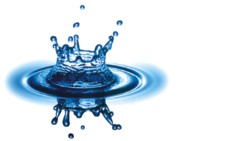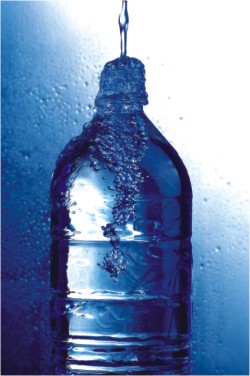Science Feature
The strangest liquid:
Why water is so weird
Edwin Cartlidge
 THE fact that the ice cube floats is the first oddity. And the mystery deepens if you take a thermometer and measure the temperature of the water at various depths. At the top, near the ice cube, you'll find it to be around 0 °C, but at the bottom it should be about 4 °C. That's because water is denser at 4°C than it is at any other temperature - another strange trait that sets it apart from other liquids. THE fact that the ice cube floats is the first oddity. And the mystery deepens if you take a thermometer and measure the temperature of the water at various depths. At the top, near the ice cube, you'll find it to be around 0 °C, but at the bottom it should be about 4 °C. That's because water is denser at 4°C than it is at any other temperature - another strange trait that sets it apart from other liquids.
Water's odd properties don't stop and some are vital to life. Because ice is less dense than water, and water is less dense at its freezing point than when it is slightly warmer, it freezes from the top down rather than the bottom up. So even during the ice ages, life continued to thrive on lake floors and in the deep ocean. Water also has an extraordinary capacity to mop up heat, and this helps smooth out climatic changes that could otherwise devastate ecosystems.
Yet despite water's overwhelming importance to life, no single theory had been able to satisfactorily explain its mysterious properties - until now. If we can believe physicists Anders Nilsson at Stanford University, California, and Lars Pettersson of Stockholm University, Sweden, and their colleagues, we could at last be getting to the bottom of many of these anomalies.
Their controversial ideas expand on a theory proposed more than a century ago by Wilhelm Roentgen, the discoverer of X-rays, who claimed that the molecules in liquid water pack together not in just one way, as today's textbooks would have it, but in two fundamentally different ways.
Key to the understanding of water's mysteries is the way its molecules - made up of two hydrogen atoms and one oxygen atom - interact with one another. The oxygen atom has a slight negative charge while the hydrogen atoms share a compensating positive charge. As such, the hydrogen and oxygen atoms of neighbouring molecules are attracted to one another, forming a link called a hydrogen bond.
Hydrogen bonds are far weaker than the bonds that link the atoms within molecules together, and so are continually breaking and reforming, but they are at their strongest when molecules are arranged so that each hydrogen bond lines up with a molecular bond (see diagram). The shape of a water molecule is such that each H2O molecule is surrounded by four neighbours arranged in the shape of a triangular pyramid - better known as a tetrahedron.
At least, that's the way the molecules arrange themselves in ice. According to the conventional view, liquid water has a similar, albeit less rigid, structure, in which extra molecules can pack into some of the open gaps in the tetrahedral arrangement. That explains why liquid water is denser than ice - and it seems to fit the results of various experiments in which beams of X-rays, infrared light and neutrons are bounced off samples of water.
 True, some physicists had claimed that water placed under certain extreme conditions may separate into two different structures (see "Extreme water"), but most had assumed it resumes a single structure under normal conditions. True, some physicists had claimed that water placed under certain extreme conditions may separate into two different structures (see "Extreme water"), but most had assumed it resumes a single structure under normal conditions.
Then, 10 years ago, a chance discovery by Pettersson and Nilsson called this picture into question. They were using X-ray absorption spectroscopy to investigate the amino acid glycine. The peaks in the X-ray absorption spectrum can shed light on the precise nature of the target substance's chemical bonds, and hence on its structure. Importantly, the researchers had got hold of a new, high-power X-ray source with which they were able to make more sensitive and accurate measurements than had ever been possible. They soon realised that the water containing their glycine sample was producing a far more interesting spectrum than the amino acid. "What we saw there was sensational," Nilsson recalls, "so we had to get to the bottom of it."
The feature that sparked their interest was a peak in the absorption spectrum that is not predicted by the traditional model of liquid water. In fact, in a paper published in 2004 they concluded that at any given moment 85 per cent of the hydrogen bonds in water must be weakened or broken, far more than the 10 per cent predicted by the textbook model.
The implications of this finding are dramatic: it suggests that a total rethink of the structure of water is needed. So Nilsson and Pettersson turned to other X-ray experiments to confirm their claims. Their first move was to enlist the help of Shik Shin of the University of Tokyo, Japan, who specialises in a technique called X-ray emission spectroscopy. The key thing about these spectra is that the shorter the wavelength of the X-rays in a substance's emission spectrum are, the looser the hydrogen bonding must be.
The team struck gold: the spectrum of emitted X-rays included two peaks that might correspond to two separate structures. The spike of the longer-wavelength X-rays, the researchers argued, indicates the proportion of tetrahedrally arranged molecules, while the shorter-wavelength peak reflects the proportion of disordered molecules.
Importantly, the shorter-wavelength peak in the X-ray emissions was the more intense of the two, suggesting that the loosely bound molecules must be more prevalent within the sample - an assertion that fitted the team's previous models. What's more, they also found that this peak shifts to an even shorter wavelength as the water is heated, while the other peak remains more or less fixed.That suggests that the hydrogen bonds connecting molecules arranged in a disordered way are more likely to loosen upon heating than those linking the more regularly arranged molecules - which again is what the team had predicted. They then reanalysed older experimental data that had seemed to support the traditional picture of water - and now argue that these results, too, are consistent with the new model.
If the team is right, another question arises: how large are the different structures within the liquid? To find out, they turned to the high-power X-rays generated at the Stanford Synchrotron Radiation Lightsource in California, this time measuring how water scatters rays arriving from various angles. The results, they say, reveal that water is dotted with small regions of tetrahedrally arranged molecules, each region being 1 to 2 nanometres across. Combined with further measurements carried out by Uwe Bergmann at Stanford University, they concluded that the ordered structures consisted of roughly 50 to 100 molecules, on average, surrounded by a sea of the more loosely bound molecules. These regions are not fixed, however. In less than a trillionth of a second, water molecules are thought to fluctuate between the two states as the hydrogen bonds break and reform.
"Our understanding of water is an evolving picture," Pettersson says. "Further research by many different groups is needed before this exciting and important journey can end." With so much to gain, who could disagree?
(Courtesy: New Scientist)
| 